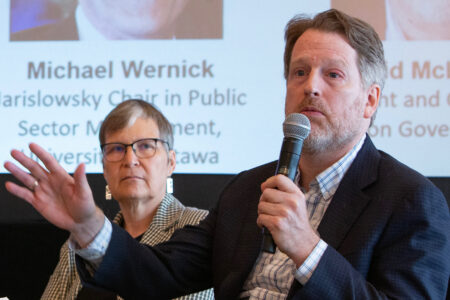
(This article has been translated from French.)
Under the Paris Agreement, Canada agreed to reduce its greenhouse gas (GHG) emissions by 30 percent compared to 2005 levels. While this goal needs to be revised to align with the science on climate change, the election campaign has brought this commitment to the forefront and raised an important question: Is Canada on track to achieve its GHG emissions target? The answer is complex.
We need to be wary of statements that say that we have already, in 2019, missed our goal of substantially reducing GHG emissions by 2030. Instead, we must focus on evaluating our progress toward our 2030 GHG emission reduction goal and adjust accordingly. These evaluations can be done using the Environmental Sustainability Indicators that the federal government updates each year.
Since 2011, Canada has been publishing its greenhouse gas emissions projections, a reliable reference. These projections have been formulated and revised under both Conservative and Liberal governments, and the team of modelling specialists that develops them has remained largely unchanged over the years. The comparisons are therefore non-partisan.
A note of caution, however. The projections for 2030 contain a degree of uncertainty because they rely on complex data used to model the emissions. On the one hand, they are based on a number of assumptions involving such factors as the growth rate of the population and of the GDP, technological innovation and implementation as well as world price trends for natural gas and oil. On the other hand, the projections must take into account the diversity of federal and provincial policies that affect the carbon pollution produced by heavy industries, all while attempting to anticipate changes in individual behaviours as far out as 2030.
Canada’s GHG emissions are declining
While GHG emissions have fluctuated over the past 10 years, federal government forecasts indicate that they will decline over the next 10 years (see graph below).
Prior to 2016, Canada had a gap of 300 megatonnes (Mt) equivalent of carbon dioxide between its 2030 target and projected emissions, which at the time stood at 815 Mt. Beginning in 2016, the government brought in new climate policies (see below) in response to its obligations under the Paris Agreement, which resulted in lowered projections for our emissions. The most recent report on GHG projections (2018) assumes that all planned policies will be implemented, including those that relate to the Land Use, Land Use Change and Forestry sector (LULUCF). This sector takes into account what is known as “natural solutions,” that is, land-planning practices that increase the amount of carbon capture. According to this report, the gap between our GHG reduction target — namely 513 Mt by 2030 ― and our projected emissions — namely 592 Mt, has therefore been reduced to 79 Mt, which brings us to a reduction of 19 percent below 2005 levels. It should be noted, however, that some measures, such as investments in mass transit, have not been modelled in the projections and could contribute to a possible partial reduction in this 79 Mt gap. Nonetheless, additional measures will need to be implemented in the future to achieve 30 percent reductions.
Canada’s gap is getting smaller: we’re thus getting closer to our target.
The 2030 target and provincial policies
Contrary to certain ideas being conveyed during this election campaign, Canada’s climate policies will indeed allow us to reduce our GHG emissions over the next 10 years without hampering economic growth. Our goal for 2030 is therefore within reach, provided the policies in question remain in place and additional efforts are made to reduce our emissions by another 79 Mt.
Public policies that make these reductions possible include:
- the federal Clean Fuel Standard;
- carbon pricing;
- the federal regulation to eliminate coal-burning power plants by 2030;
- additional regulations on energy efficiency.
We must also consider provincial climate policies, as two recently elected provincial governments have cancelled programs and policies intended to reduce GHG emissions. Ontario’s withdrawal from the Quebec-California carbon market, its elimination of renewable energy investment programs and the adoption of a less-ambitious climate action plan will add another 30 Mt to Canada’s carbon emissions between now and 2030. In addition, Alberta, ignoring the climate emergency, has eliminated its price on carbon along with other climate-related measures while continuing to expand oil and gas production. These decisions will have serious consequences on Canada’s GHG emissions profile.
Provincial climate policies thus have a major impact on our GHG emissions. As numerous economists have pointed out, having a uniform carbon price in Canada is a key factor in ensuring that our GHG emissions are reduced. We need to prevent polluting activities from moving to provinces where the cost of carbon pollution is cheaper.
The Court of Appeal for Ontario recently ruled in favour of allowing the federal government to intervene in the setting of standards to regulate GHG emissions throughout the country. In light of the climate emergency, it ruled that while the provinces have the power to establish measures to combat pollution and GHG emissions within their borders, only Parliament can impose minimum standards for the entire country, as it does with carbon pricing. The court also pointed out that the refusal of certain provinces to implement these types of measures causes injury to those provinces that are taking climate change seriously, thereby creating an inequity for the provinces that are being proactive.
So, let’s come back to the original question: Are we on track to achieving our GHG emissions reduction target? According to the data, it seems that we are getting closer to it, but only under certain conditions: the continuation of climate policies currently in place and the full participation of all of Canadian provinces in the fight against the climate emergency.
However, Canada’s current target does not go far enough. Under the Paris Agreement, the signatories agreed to keep planet warming substantially below 2oC and to encourage continuing efforts to limit temperature rise to 1.5oC. Canada’s target for 2030 was adopted by the previous government and has not been modified. To avoid a temperature rise of more than 1.5oC, the Intergovernmental Panel on Climate Change (IPCC) recommended in its 2019 report that, worldwide emissions be reduced by 45 percent by 2030 compared with 2010 levels, and that net emissions be reduced to zero by 2050. And this doesn’t take into account Canada’s historic responsibility as a wealthy country. We need to do more. Much more.
Though we’re headed in the right direction, Canada’s current target puts us only halfway up the mountain. The summit that we need to reach to avoid the most devastating impact of climate change is much higher. A difficult hike awaits us, but they say that the view from the summit is magnificent.
This article is part of the Election 2019 feature.
Photo : Shutterstock by Elnur
Do you have something to say about the article you just read? Be part of the Policy Options discussion, and send in your own submission. Here is a link on how to do it. | Souhaitez-vous réagir à cet article ? Joignez-vous aux débats d’Options politiques et soumettez-nous votre texte en suivant ces directives.









